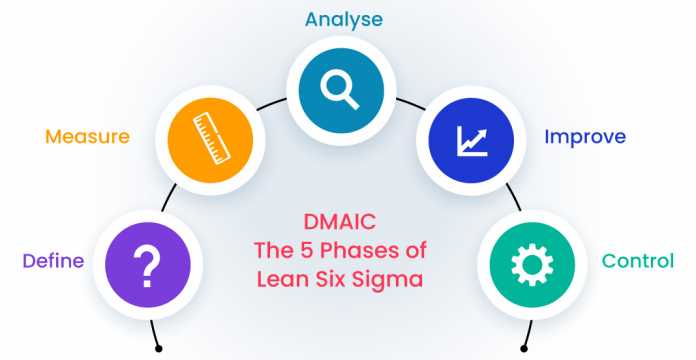
Lean Six Sigma is a process improvement methodology that combines the best of Lean and Six Sigma tools and techniques. Lean and Six Sigma are similar in terms of their goals, both work towards creating a high-quality product that matches the customer’s requirement. However, they differ in their approaches but work best when combined.
Lean is a systematic approach that aims to remove the waste process and consider only those that add value to the whole system. Six Sigma, on the other hand, aims to reduce defects and is purely based on numbers and statistics. When combined, they have the potential to deliver better results.
DMAIC is a widely used methodology and forms the foundation of the Lean Six Sigma processes. It aims at improving the flaws and defects in the existing projects or processes in your organization.
Importance of DMAIC
It is pronounced as de-MAY-ick, which is a methodology that helps projects that require improvement. This science-based method helps you to implement Lean Six Sigma in your projects, which has enough room for improvement.
If your project has:
- An obvious problem in the process
- A potential to add to the company or organization’s goal, by improving the process
- Data that can be measured and analyzed
Then it is ready to undergo a process enhancement through the DMAIC methodology. It helps you identify the root cause of the problem and creates room for brainstorming the appropriate solutions to address the issues.
The main aim of DMAIC is to improve the overall process.
The acronym DMAIC stands for:
Define- Measure-Analyse-Improve- Control.
The name itself gives out the five stages of this data-driven methodology.
Let’s get started with the first stage: Defining the goals.
Define
Lean Six Sigma primarily focuses on customer satisfaction. Therefore, project managers need to identify the problem that requires improvement. For this, you need to understand the issues as a whole and understand the customers’ preferences.
In this first step towards your process improvement, you and your team need to clearly define the issues and the action plan required to achieve the results.
For this, you need to define a problem statement. You can use available data to confirm if the issue raised is relevant. Doing so it will help you to:
- Prioritize the issue as high, low, or medium
- Understand the areas where it will impact example: businesses, finance, technology, etc
- Get an idea of the available resources.
Once you sort out the problem statement and outline of the work process, you can start working on the project. The next steps that follow ensure the process moves positively towards the goal.
Measure
As you start working on the project, you need to keep a check on its progress and performance.
You have to be vigilant about the project. For the first assessment, you need to jot down the “current stage” and use it as a baseline for the following assessments. It will act as a reference to measure the improvements made in the project.
Since you will need data to analyze the root cause of the waste and its consequent issues, you can use this step to plan out a way to collect as much measurable data as possible.
For this, constant updates from the team will be useful. One thing to ensure while collecting the data is its source. Data has to be reliable and from a confirmed source.
For more effectiveness, you can update the data regularly in your workflow tools like a project charter.
Analyze
The main aim of this step is to get to the root of the problem. You can leverage the data you collected from the previous stages to understand its primary cause.
Along with the data, the whole process also comes under the radar of the team manager. It is crucial to analyze the improvements.
Use the data and observations to list out the issues and concerns within the process. The team can participate in sharing their viewpoints to add value to the whole process.
Since Lean Six Sigma Focuses on eliminating waste within the process,
the analysis consists of analyzing the process in terms of:
- Time: How well the project members utilize the time. Are there any lags due to long unnecessary breaks? Or is there any other reason that drags the project off its stipulated timeline?
- Value: How well is the project moving towards achieving customer satisfaction? How is it adding value in terms of efficiency and high-quality product?
- Value Stream Mapping: You can use the data to map the process and identify the areas where the waste processes are happening. It will enable you to make informed decisions to add or delete a particular step of a process.
Improve
Once you gather the data and analyze what exactly is the cause of the problem in question, you and your team need to find ways to fix it.
This step aims at improving the overall process using the data and the analysis report. These improvements need to be implemented at the right time to get the desired results. Therefore you need to prepare a proper plan of action and a team efficient enough to bring out innovative solutions to the table.
One thing to consider here is that solutions need to be practical. They should easily be implemented and don’t add considerably to the budget of the project. You must also take other project constraints like available workforce, and technological support into consideration.
Once you figure out the solutions, it’s time for their implementation. Here you need to measure the improvements and record the same. To make things easier, you should note down the changes which lead to improved the whole process.
Control
It is the fifth stage of the DMAIC method and ensures the sustainability of the improvements made. You have to make sure that the issues do not get repeated.
You need to make sure that the whole process is following the Lean Six Sigma Principles. If you find any deviation, the same should be noted and brought to notice.
For this, your team can build a monitoring algorithm where you can decide the various levels where the process will operate. You can also strategize the plan of action at these levels to make sure the improvements are visible.
Also, you may encourage your team members to update the data and noticeable improvements at every stage. This record comes in handy for the control phase.
You can use this record to analyze the loopholes in your DMAIC implementation if any.
Conclusion
DMAIC includes five stages that are sequential and yield the best results when done in iterative form.
These stages complement each other, and in some cases, work together iteratively. For example, when you collect the data in the Measure phase, you may have to analyze and correct it until your team can narrow it down to identify the root cause of the problem.
DMAIC is the core of the Lean Six Sigma process. You can implement it for the improvement of the existing projects in your organization.
Implementing DMAIC requires a thorough understanding of Lean and Six Sigma principles. This can be achieved by training the workforce in globally-recognized Six Sigma Certifications and Quality Management Courses from an Accredited Training Organization.
Some of the popular quality management certification courses that individuals and enterprise teams can take up are:
Six Sigma Green Belt Training
Lean Black Belt Certification
Lean Six Sigma Yellow Belt Certification Training
Lean Fundamentals Training














